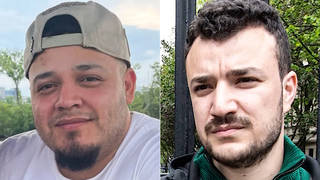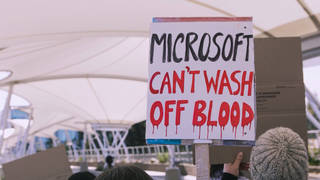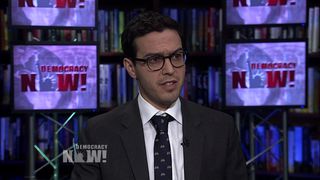
Topics
Guests
- Seth Freed Wesslerreporter with The Investigative Fund. His new story for The Nation magazine is called “This Man Will Almost Certainly Die.” The story is also part of this week’s episode of Reveal, a public radio show and podcast from the Center for Investigative Reporting.
A shocking new investigation about private prisons has revealed dozens of men have died in disturbing circumstances inside these facilities in recent years. The investigation published in The Nation magazine documents more than 100 deaths at private, immigrant-only prisons since 1998. The investigation’s author, Seth Freed Wessler, spent more than two years fighting in and out of court to obtain more than 9,000 pages of medical records that private prison contractors had submitted to the Bureau of Prisons. We speak to Wessler about his piece, “This Man Will Almost Certainly Die.”
Transcript
JUAN GONZÁLEZ: We turn now to a shocking new investigation about private prisons and the dozens of men who have died in disturbing circumstances inside these facilities in recent years. The investigation, published in The Nation magazine this month, documents more than 100 deaths at private, immigrant-only prisons since 1998.
The investigation’s author, Seth Freed Wessler, spent more than two years fighting in and out of court to obtain more than 9,000 pages of medical records that private prison contractors had submitted to the Bureau of Prisons. The documents are stunning. They reveal more than two dozen cases of inadequate medical care that independent doctors say contributed to the premature deaths of the prisoners. One man died shackled to his bed from an undiagnosed HIV-related infection in his brain. Other men died from lack of medical care for cancer and liver disease. Several men were denied adequate mental health treatment and went on to commit suicide.
AMY GOODMAN: This comes as the Democratic presidential candidates are increasingly speaking out against multimillion-dollar private prison contracts. In September, Vermont Senator Bernie Sanders introduced a bill to ban government contracts with private prison companies at the federal, state and local level within three years. In October, former Secretary of State Hillary Clinton also pledged to ban the use of private prison companies. The Clinton campaign later said it would stop accepting money from lobbying groups linked to private prisons and that it would donate the money it had already received.
Well, to talk about this and more, we’re joined by the author of the new investigation, Seth Freed Wessler, reporter with The Investigative Fund, his new story for The Nation called “This Man Will Almost Certainly Die.”
Seth, welcome to Democracy Now! Explain the title, “This Man Will Almost Certainly Die.”
SETH FREED WESSLER: That title comes from a quote that was left in one of the medical files I obtained through an open records request. I obtained 9,000 pages of documents. And in those documents, from one of these prisons, there was a medical doctor who left his normal medical notes, but he also left a series of notes railing against the system that he had—he worked in, inside of one of these private federal prisons, private federal prisons used only to hold noncitizens convicted of federal crime—a sort of segregated system of prisons. In these files, he left a series of notes where he was railing against this prison system, basically saying that it wasn’t providing prisoners, or wasn’t allowing him to provide prisoners, the kind of care that as a medical doctor he believed he should be able to provide. These records tell the stories of 103 men who died inside this federal subsystem of prisons.
If you’re convicted of a crime in the United States, a federal crime, and you’re a noncitizen considered a low-security prisoner, you’re likely to be sent to a different prison from all of the rest of—from citizens. And those prisons are nearly the only prisons that the Federal Bureau of Prisons has privatized, has contracted out to private companies—GEO Group, Corrections Corporation of America, Management and Training Corporation.
And what I found is that the federal government is applying a different and less stringent set of rules to these prisons. And that, in the context of medical care, is leading to stripped-down kinds of medical clinics with lower-trained, lesser-paid, less expensive workers. And in dozens of cases, prisoners held inside are facing medical neglect. In 25 cases I looked at, doctors who reviewed the files said these prisoners likely would have lived had they received adequate medical care.
JUAN GONZÁLEZ: Well, Seth, could you—how did these develop? In other words, what’s the rationale for them segregating off the noncitizens into separate prisons? And also, talk a little bit about the evolution. When did they begin to flower or develop as a form of institutionalization of inmates?
SETH FREED WESSLER: Sure. So, private prisons, in general, they have existed for decades. But it took until the ’90s, the late ’90s, for the Bureau of Prisons to begin privatizing. The Bureau of Prisons had resisted privatization until the late ’90s, when the Clinton administration proposed in its 1996 budget request a plan to privatize a subset of federal prisons, to see if in fact they could save money. This was a time when the Clinton administration was promising not to expand the size of the federal workforce, but also prisons were growing. So, when prisons grow, federal prisons grow, usually that means more workers. The solution they found was to privatize federal prisons.
Well, very soon, as these prisons started to open, the federal government began to incarcerate only noncitizens inside of most of its federal prisons that have been privatized. The logic is, as recently as 2014, the Bureau of Prisons said that noncitizens are an ideal group of people to hold in privatized federal facilities that have somewhat fewer resources and services, because these people will later be transferred to immigration authorities and deported, after they serve their time. So they’ve explicitly said that these are sort of stripped-down facilities.
JUAN GONZÁLEZ: But you’ve also noted that a lot of the people that are incarcerated are basically—the crimes they’ve committed is re-entry into the United States, not necessarily—
SETH FREED WESSLER: That’s right.
JUAN GONZÁLEZ: —an actual crime here in the U.S.
SETH FREED WESSLER: That’s right. In fact, 40 percent of the people inside of these prisons are incarcerated for the criminal offense of crossing over the border. In the early '90s, 4,000 people were prosecuted criminally for crossing over the border. By 2013, at the peak of these prosecutions under the Obama administration, 91,000 people were prosecuted criminally for illegal entry or illegal re-entry, for crossing the border—something we usually think of as a civil offense. You know, usually, people are detained and deported as a result of crossing the border without papers. But we've started to incarcerate, sometimes for years, tens of thousands of people.
AMY GOODMAN: And just to be clear, these are not the immigrant detention facilities.
SETH FREED WESSLER: That’s right. These are a different system. So, Immigration and Customs Enforcement oversees immigration detention. There are additional 23,000 people in a separate prison system that’s overseen by the Bureau of Prisons used to hold noncitizens. And I uncovered stories of people who were facing incredible kinds of medical neglect, men who complained of illness for, in one case, two years and was never seen by doctor. This man, Claudio Fagardo-Saucedo, was actually never tested for HIV, despite the fact that there were signs that he should have been, and that federal rules would have it that he should have been. He was never tested for HIV, 'til he became so sick that he fell down. He was so weak that he fell down while walking in the prison, and he was sent to a local hospital, tested positive for HIV, and died days later of an AIDS-related brain infection. It's just sort of staggering levels of neglect.
AMY GOODMAN: I want to turn to your interview, Seth, with Dr. John Farquhar, the former clinical director at the Federal Correctional Institution in Big Spring, Texas. This was featured on Reveal, a podcast from the Center for Investigative Reporting.
DR. JOHN FARQUHAR: There were times when I was critical. I’m a critical person, starting with myself.
SETH FREED WESSLER: You actually wrote at one point, “I feel bad for his shabby care.”
DR. JOHN FARQUHAR: Well, I stand by that statement. I don’t know who it’s about, and I can’t comment on any single record of any person. But there are times when the care was not what I wanted for any patient, period.
AMY GOODMAN: Dr. Farquhar went on to suggest the contractors asked him to cut down on number of 911 calls made out of prison.
DR. JOHN FARQUHAR: They said, you know, “Is there a way that we can cut this down?” And I said, “Probably, yes.”
SETH FREED WESSLER: I could imagine that could result in a pressure to not call when somebody really needs to go to the emergency room.
DR. JOHN FARQUHAR: That’s always the risk. That’s why professional judgment takes professional training and professional experience, because you can’t leave it up to anybody.
AMY GOODMAN: In this clip, we hear Russell Amaru, a physician assistant at Big Spring. He was on the call the night a prisoner named Nestor Garay had a seizure or a stroke. Garay spoke about the facility’s high reliance on LPNs, or licensed practical nurse.
RUSSELL AMARU: There would have been a more aggressive care for that patient, and other patients, too, if we had better training, better staff. It’s just so many things are wrong there. You had an LPN right out of school, new in corrections, trying to make an assessment. He did not have the skills. I don’t blame them as a person; I blame the management system that puts him in that position. Basically, what you have, in essence, is people that are undertrained doing jobs that they shouldn’t be doing. We do not have an infirmary for 24-hour observation. Charts are often temporarily lost for a couple of days or a week or so. And so, the companies that I work for, they’ve got the model of how the place is supposed to be run, and they seem to allow it. And I know you want to ask me: What I would do to correct the problem? I’d close this whole facility down, and I’d start over again.
AMY GOODMAN: “I’d close this whole facility down,” says Russell Amaru, a physician assistant at Big Spring. Seth, “This Man Will Almost Certainly Die,” your piece, dozens of men dying in disturbing circumstances in privatized, immigrant-only prisons—where is this all going?
SETH FREED WESSLER: Well, the Bureau of Prisons has made a decision that they aren’t going to apply the same rules and standards to privatized prisons used to hold immigrants that it applies to the rest of its prison system. That means that these private companies are free to determine how they’re going to provide care. One of the ways that that happens is by employing lesser-trained, less expensive workers, as the person we just heard talked about. This is a subsystem of federal prisons that’s run by the Bureau of Prisons, and there are real questions about why it is that there is a separate, segregated system of federal prisons for noncitizens, segregated on the basis of citizenship, where people are suffering really incredible kinds of medical neglect.
AMY GOODMAN: Seth Freed Wessler, we’re going to do Part 2 after this interview and post it at democracynow.org. Seth Freed Wessler is a reporter with The Investigative Fund. His new story for The Nation magazine, “This Man Will Almost Certainly Die,” we will link to it at democracynow.org.
And that does it for our broadcast. We have several job openings. Check our website at democracynow.org.
WATCH NEXT
Part 2: Seth Freed Wessler on Uncovering the Deaths of Dozens at Privatized Immigrant-Only Jails












Media Options